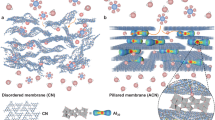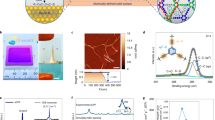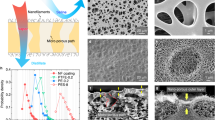Abstract
Desalination can help to alleviate the fresh-water crisis facing the world. Thermally driven membrane distillation is a promising way to purify water from a variety of saline and polluted sources by utilizing low-grade heat. However, membrane distillation membranes suffer from limited permeance and wetting owing to the lack of precise structural control. Here, we report a strategy to fabricate membrane distillation membranes composed of vertically aligned channels with a hydrophilicity gradient by engineering defects in covalent organic framework films by the removal of imine bonds. Such functional variation in individual channels enables a selective water transport pathway and a precise liquid–vapour phase change interface. In addition to having anti-fouling and anti-wetting capability, the covalent organic framework membrane on a supporting layer shows a flux of 600 l m–2 h–1 with 85 °C feed at 16 kPa absolute pressure, which is nearly triple that of the state-of-the-art membrane distillation membrane for desalination. Our results may promote the development of gradient membranes for molecular sieving.
This is a preview of subscription content, access via your institution
Access options
Access Nature and 54 other Nature Portfolio journals
Get Nature+, our best-value online-access subscription
$29.99 / 30 days
cancel any time
Subscribe to this journal
Receive 12 print issues and online access
$259.00 per year
only $21.58 per issue
Buy this article
- Purchase on Springer Link
- Instant access to full article PDF
Prices may be subject to local taxes which are calculated during checkout





Similar content being viewed by others
Data availability
The authors declare that the data supporting the findings of this study are available within the paper and its Supplementary Information files. Source data are provided with this paper. Additional data is available from the authors upon request.
References
Elimelech, M. & Phillip, W. A. The future of seawater desalination: energy, technology, and the environment. Science 333, 712–717 (2011).
Shannon, M. A. et al. Science and technology for water purification in the coming decades. Nature 452, 301–310 (2008).
Deshmukh, A. et al. Membrane distillation at the water-energy nexus: limits, opportunities, and challenges. Energ. Environ. Sci. 11, 1177–1196 (2018).
Alkhudhiri, A., Darwish, N. & Hilal, N. Membrane distillation: a comprehensive review. Desalination 287, 2–18 (2012).
Wang, P. & Chung, T. S. Recent advances in membrane distillation processes: membrane development, configuration design and application exploring. J. Membr. Sci. 474, 39–56 (2015).
Ali, A. et al. Membrane technology in renewable-energy-driven desalination. Renew. Sust. Energ. Rev. 81, 1–21 (2018).
Drioli, E., Ali, A. & Macedonio, F. Membrane distillation: recent developments and perspectives. Desalination 356, 56–84 (2015).
González, D., Amigo, J. & Suárez, F. Membrane distillation: perspectives for sustainable and improved desalination. Renew. Sust. Energ. Rev. 80, 238–259 (2017).
Camacho, L. et al. Advances in membrane distillation for water desalination and purification applications. Water 5, 194–196 (2013).
Rezaei, M. et al. Wetting phenomena in membrane distillation: mechanisms, reversal, and prevention. Water Res. 139, 329–352 (2018).
Chen, W. et al. High-flux water desalination with interfacial salt sieving effect in nanoporous carbon composite membranes. Nat. Nanotechnol. 13, 345–350 (2018).
Liao, Y., Wang, R. & Fane, A. G. Fabrication of bioinspired composite nanofiber membranes with robust superhydrophobicity for direct contact membrane distillation. Environ. Sci. Technol. 48, 6335–6341 (2014).
Hou, D. et al. Composite membrane with electrospun multiscale-textured surface for robust oil-fouling resistance in membrane distillation. J. Membr. Sci. 546, 179–187 (2018).
Tang, N. et al. Preparation and morphological characterization of narrow pore size distributed polypropylene hydrophobic membranes for vacuum membrane distillation via thermally induced phase separation. Desalination 256, 27–36 (2010).
Huang, Q.-L. et al. Electrospun ultrafine fibrous PTFE-supported ZnO porous membrane with self-cleaning function for vacuum membrane distillation. J. Membr. Sci. 534, 73–82 (2017).
Wang, W. et al. Trade-off in membrane distillation with monolithic omniphobic membranes. Nat. Commun. 10, 3220 (2019).
Cote, A. P. et al. Porous, crystalline, covalent organic frameworks. Science 310, 1166–1170 (2005).
Diercks, C. S. & Yaghi, O. M. The atom, the molecule, and the covalent organic framework. Science 355, eaal1585 (2017).
Huang, N., Wang, P. & Jiang, D. Covalent organic frameworks: a materials platform for structural and functional designs. Nat. Rev. Mater. 1, 16068 (2016).
Jin, Y., Hu, Y. & Zhang, W. Tessellated multiporous two-dimensional covalent organic frameworks. Nat. Rev. Chem. 1, 0056 (2017).
Ding, S. Y. & Wang, W. Covalent organic frameworks (COFs): from design to applications. Chem. Soc. Rev. 42, 548–568 (2013).
Yuan, J. et al. Covalent organic framework-modulated interfacial polymerization for ultrathin desalination membranes. J. Mater. Chem. A 7, 25641–25649 (2019).
Xu, L., Shan, B., Gao, C. & Xu, J. Multifunctional thin-film nanocomposite membranes comprising covalent organic nanosheets with high crystallinity for efficient reverse osmosis desalination. J. Membr. Sci. 593, 117398 (2020).
Matsumoto, M. et al. Lewis-acid-catalyzed interfacial polymerization of covalent organic framework films. Chem 4, 308–317 (2018).
Shinde, D. B. et al. Crystalline 2D covalent organic framework membranes for high-flux organic solvent nanofiltration. J. Am. Chem. Soc. 140, 14342–14349 (2018).
Colson, J. W. et al. Oriented 2D covalent organic framework thin films on single-layer graphene. Science 332, 228–231 (2011).
Sick, T. et al. Oriented films of conjugated 2D covalent organic frameworks as photocathodes for water splitting. J. Am. Chem. Soc. 140, 2085–2092 (2018).
Zhou, D. et al. Synthesis of C–C bonded two-dimensional conjugated covalent organic framework films by Suzuki polymerization on a liquid–liquid interface. Angew. Chem. Int. Ed. 58, 1376–1381 (2019).
Fan, J., W., H. & Wang, F. Evaporation-driven liquid flow through nanochannels. Phys. Fluids 32, 012001 (2020).
Feng, S. & Xu, Z. Edges facilitate water evaporation through nanoporous graphene. Nanotechnology 30, 165401 (2019).
Li, Y. et al. Ultrafast diameter-dependent water evaporation from nanopores. ACS Nano 13, 3363–3372 (2019).
Lu, K. J., Chen, Y. & Chung, T. S. Design of omniphobic interfaces for membrane distillation – a review. Water Res. 162, 64–77 (2019).
Huang, Y. X., Wang, Z., Jin, J. & Lin, S. Novel Janus membrane for membrane distillation with simultaneous fouling and wetting resistance. Environ. Sci. Technol. 51, 13304–13310 (2017).
Zuo, G. & Wang, R. Novel membrane surface modification to enhance anti-oil fouling property for membrane distillation application. J. Membr. Sci. 447, 26–35 (2013).
AbdulHalim, R. G. et al. A fine-tuned metal–organic framework for autonomous indoor moisture control. J. Am. Chem. Soc. 139, 10715–10722 (2017).
Kandambeth, S. et al. Self-templated chemically stable hollow spherical covalent organic framework. Nat. Commun. 6, 6786 (2015).
Halder, A. et al. Ultrastable imine-based covalent organic frameworks for sulfuric acid recovery: an effect of interlayer hydrogen bonding. Angew. Chem. Int. Ed. 57, 5797–5802 (2018).
Wang, W. et al. Simultaneous production of fresh water and electricity via multistage solar photovoltaic membrane distillation. Nat. Commun. 10, 3012 (2019).
Xue, Y. L. et al. Tailoring the molecular structure of crosslinked polymers for pervaporation desalination. Nat. Commun. 11, 1461 (2020).
Lee, J., Laoui, T. & Karnik, R. Nanofluidic transport governed by the liquid/vapour interface. Nat. Nanotechnol. 9, 317–323 (2014).
Wang, Z., Jin, J., Hou, D. & Lin, S. Tailoring surface charge and wetting property for robust oil-fouling mitigation in membrane distillation. J. Membr. Sci. 516, 113–122 (2016).
She, Q., Wang, R., Fane, A. G. & Tang, C. Y. Membrane fouling in osmotically driven membrane processes: a review. J. Membr. Sci. 499, 201–233 (2016).
Wang, Z., Hou, D. & Lin, S. Composite membrane with underwater-oleophobic surface for anti-oil-fouling membrane distillation. Environ. Sci. Technol. 50, 3866–3874 (2016).
Acknowledgements
This research was supported by the analysis and testing centre of the Beijing Institute of Technology for basic characterization. We acknowledge D. Lu and J. Li from Tsinghua University for their suggestions on mechanism discussion. C.J. appreciates the help from M. Wu. B.W. acknowledges financially support from the National Natural Science Foundation of China (grant nos 21625102 and 21971017), National Key Research and Development Program of China (2020YFB1506300), Beijing Municipal Science and Technology Project (Z181100004418001) and Beijing Institute of Technology Research Fund Program. X.F. acknowledges support from the National Natural Science Foundation of China (grant nos 21922502 and 21674012). R.Y. acknowledges support from the 1331 Project of Shanxi Province. F.W. acknowledges support from the Strategic Priority Research Program of the Chinese Academy of Sciences (XDB22040402) and the CAS Youth Innovation Promotion Association.
Author information
Authors and Affiliations
Contributions
X.F. and B.W. conceived the research and supervised the project. S. Zhao and C.J. developed the COF films synthesis, conducted the experiments, designed measurement devices and analysed the experimental results. J.F., F.W. and H.W. performed the theoretical calculations. S.H., Y.L., H.L., H.Z. and S. Zhang performed part of the MD performance test. R.Y., L.G., Y.M., Jianqi Zhang and Jinwei Zhang performed part of the structural characterization of the films. P.M., P.S., C.S., Z.G. and Y.Z. conducted part of the synthesis of the film and simulated the structure of the COF film. S. Zhao, C.J., X.F. and B.W. wrote the manuscript. All authors discussed and commented on the manuscript.
Corresponding authors
Ethics declarations
Competing interests
The authors declare no competing interests.
Additional information
Peer review information Nature Materials thanks Zhiping Lai, Huanting Wang and the other, anonymous, reviewer(s) for their contribution to the peer review of this work.
Publisher’s note Springer Nature remains neutral with regard to jurisdictional claims in published maps and institutional affiliations.
Supplementary information
Supplementary Information
Supplementary Figs. 1–35, Tables 1–8, refs. 1–24, Materials and Methods.
Supplementary Video 1
The process of transferring COFDT and COFDT-E18 films onto a cPVDF membrane.
Source data
Source Data Fig. 2
Powder X-ray diffraction source data for COFDT film.
Source Data Fig. 3
NMR, water adsorption and XPS source data for COFDT-E18 film.
Source Data Fig. 4
MD performance source data for COFDT-E18 film.
Source Data Fig. 5
Molecular dynamics simulations source data.
Rights and permissions
About this article
Cite this article
Zhao, S., Jiang, C., Fan, J. et al. Hydrophilicity gradient in covalent organic frameworks for membrane distillation. Nat. Mater. 20, 1551–1558 (2021). https://doi.org/10.1038/s41563-021-01052-w
Received:
Accepted:
Published:
Issue Date:
DOI: https://doi.org/10.1038/s41563-021-01052-w
This article is cited by
-
Linkage conversions in single-crystalline covalent organic frameworks
Nature Chemistry (2024)
-
Nanowire-assisted electrochemical perforation of graphene oxide nanosheets for molecular separation
Nature Communications (2024)
-
Covalent organic framework membrane for efficient removal of emerging trace organic contaminants from water
Nature Water (2023)
-
A self-standing three-dimensional covalent organic framework film
Nature Communications (2023)
-
Chemically routed interpore molecular diffusion in metal-organic framework thin films
Nature Communications (2023)



